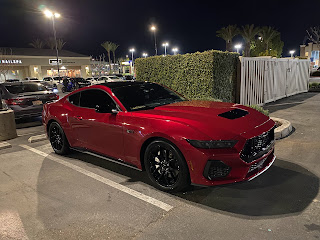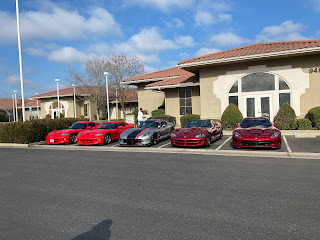The most well-known, iconic, and best-selling American pony car in the Ford Mustang has been redesigned for 2024, entering its seventh generation. Not only is it an evolution of the previous Mustang, but significant upgrades and other changes were made as well. The new Mustang is currently offered in EcoBoost, GT, and Dark Horse versions, while the EcoBoost and GT also offer Premium packages and convertible forms. For the purposes of this post, I will cover the GT and Dark Horse specifically, especially since I have only taken photos of those two versions, and most enthusiasts and I care the most about the V8-powered Mustangs over any lesser version of it. The 5.0-liter Coyote V8 carries over from previous Mustang generations, except that it has been upgraded to 480 horsepower in the GT, 486 horsepower in the GT with the performance exhaust, and 500 horsepower in the Dark Horse. Torque figures remain relatively steady at 415 pound-feet in the GT and 418 pound-feet in the Dark Horse, while they improve to 481 pound-feet in the GT with the performance exhaust. Launching from zero to 60 mph occurs in 4.2 seconds for the GT and 4.1 seconds for the Dark Horse, while top speeds are set at 155 mph for the GT and 166 mph for the Dark Horse. A 10-speed automatic transmission is standard across the board with the 2024 Mustang, while the GT and Dark Horse can be optioned with a 6-speed manual as well.
The new Mustang's suspension has been revised compared to its predecessor for a better handling and driving experience. Its optional Performance Pack consists of a front strut-tower brace, Torsen limited-slip differential, wider wheels and tires, bigger Brembo brakes, and a MagneRide active-dampening suspension. Other optional performance extras include Recaro bucket seats and a Performance Electronic Parking Brake that resembles a traditional handbrake and makes the vehicle easier to drift. Inside, the cabin has received some improvements, such as a standard 12.4-inch instrument cluster, 13.2-inch infotainment screen with Ford Sync 4 software, Apple CarPlay, Android Auto, ambient lighting, Amazon Alexa and Ford Streaming voice command capabilities, Ford Power-Up that allows for over-the-air software updates and vehicle function enhancements, and an optional wireless smartphone charger. Some leather and stitched interior trim pieces are standard in the Mustang GT and Dark Horse, and a Remote Rev function was introduced on the new Mustang, allowing its engine to rev up the RPMs from the press of a button on the key fob from outside of the car.
Pricing for the 2024 Mustang GT and Dark Horse starts at $43,305 and $61,080 respectively. The first example was on display at a car show I attended in early October and marked the first 2024 Mustang that I've seen in person and the only new Mustang Dark Horse that I've seen up close to date. As for the two 2024 Mustang GTs featured in this post, I saw the red one at three different car meets that took place all within the past month, and I spotted the black one earlier this month. I have seen a handful of other 2024 Mustangs out and about, but I don't have any photos of those, and that's no big deal to me. Like with previous Mustang generations, I expect to see more of the new one on the streets and at car meets in the coming years, and I am especially looking forward to what's in store for the Shelby versions down the road. Overall, I am a fan of the new Mustang and see it as one of the best generations of the legendary pony car. In addition, I have developed a greater appreciation for the new Mustang, especially its V8-powered versions, partly due to the uncertain futures of the Chevy Camaro and Dodge Challenger, the Mustang's two chief competitors.
You can further support my blogs by checking out my merch (sample pictured below): CPF Store
















































